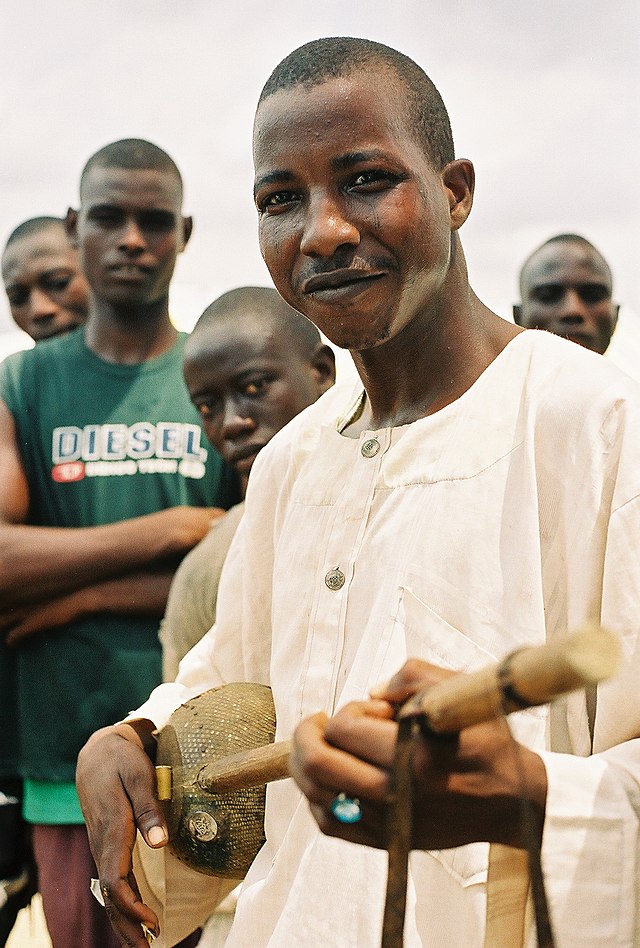Top Qs
Timeline
Chat
Perspective
Gurmi (lute)
From Wikipedia, the free encyclopedia
Remove ads
The gurmi is a two or three-stringed lute of the Hausa people of northern Nigeria.[1][2] May also be called gurumi or kumbo.[1][2] In looking at the two-finger playing style used by musicians who play the gumbri, researchers have listed it as a possible relative to the banjo.[3][4] Researchers have talked about the gurmi and gurumi as if these are two different but similar instruments.[2][5]

The instrument is also played by Toubou people and "other peoples of Niger and northern Nigeria."[5]
Remove ads
Details

It has a soundbox made from a half calabash or gourd, the opening covered with hide for a soundboard.[1][2] The neck pierces the calabash, its end poking out the bottom of the instrument. Strings are secured to the stump of stick at the bottom and run across a bridge on the hide soundboard to the neck. The strings are secured to the neck by tying them to tuning rings, separate strings or bands tied around the neck.
While a member of the xalam family of instruments, the gurmi is specific to the Hausa people.[1] Unlike the xalam, with its oval shaped soundbox, the gurmi's soundbox is round (the shape of the gourd which is its body).[4] They have a rounded dowel neck.[4]
The instrument has been traditionally played by Hausa men to make songs that praise wrestlers.[1] It may be played as a solo instrument or accompany singing.[1]
Remove ads
Variations and relatives
Summarize
Perspective
Researchers have paired the gurmi with a number of African lutes, many with names that may be related to the name gurmi.[2] The instruments are "full-spike lutes" meaning that the neck goes all the way through the instrument, poking through both sides of the gourd or calabash resonator.[2] Another alternative, separating these from other African lutes is the "semi-spike lutes" such as the xalam, in which the end of the neck pokes out through the soundboard (instead of out through the side of the gourd) and acts as a bridge.[2]
These full-spike lutes include:
- Gambare. Soninke people of Mali.[1]
- Gullum. Kilba people, Nigeria. 3 strings, round calabash soundbox, soundhole in side, a bridge that is hollow and "contains seeds".[1][2] Used at death ceremonies.[1]
- Gulum, gulom. Kotoko people, Chad, Cameroon. 3 strings, "hemispherical" calabash soundbox, covered with cowhide, laced to instrument with strips on instrument's back. Horsehair/nylon strings.[2][6]
- Gumbri, Guinbri.[1][7] Lute played by Gnawa people (descendants of West Africans brought north to Morocco as slaves).
- Gurumi. Dosso people of Niger.[1] Mauri people, southern Chad.[1]
- Gurumi. Hausa people. Niger. 2 strings, calabash soundbox.[2]
- Gurumi. Toubou people. Nigeria. 2 strings, calabash soundbox.[2]
- Kambre. Sierra Leone.[1]
- Kubru. Timbuktu, Mali.[1] 3 strings, plucked. Boat shaped soundbox, "metal-ringed jingle". Paired with diarka one-stringed fiddle.[8]
- Ngùlǎn. Bana people. Cameroon. 3 strings, calabash or gourd soundbox in bowl shape.[2][9]
- Malam Maman Barka of the Toubou people, playing an Ngurumi.
Remove ads
References
External links
Wikiwand - on
Seamless Wikipedia browsing. On steroids.
Remove ads


